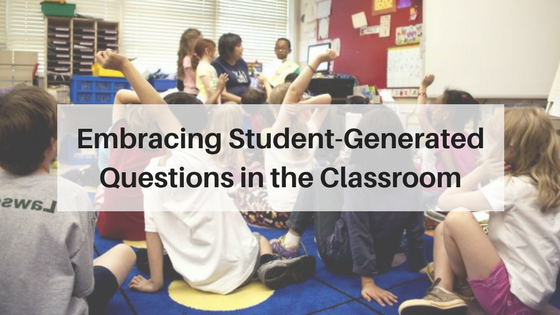Guest post by: Dr. Molly Ness
Make Way for Questions: Embracing Student-Generated Questions in the Classroom
“If there is a Big Dipper and a Little Dipper, why isn’t there a Middle Dipper?”
This question – from my six-year old niece – came as we looked into the night sky. Her question was impressive – not only in its insightfulness, but also in her eagerness to pose it.
Any parent or teacher of young children is familiar with the magnitude of questions they generate on a daily basis. On the average day, mothers typically are asked an average of 288 questions by their children aged two to ten. Research in 2007 revealed that children ask between four hundred and twelve hundred questions each week!
When children come to school, however, their questions taper off. In the vast majority of classrooms today, the responsibility for generating questions is left to the teacher. In fact, the typical teacher asks 300-400 questions a day. In most cases, questions emerge more from teachers and teachers’ manuals than directly from students.
[scroll down to keep reading]
So now, let me to pose a question (or two):
- Why are there so many student-generated questions at home, and so few at school?
- Why does this paradox exist?
- What might happen if we carve out more time for student-generated questions in the classroom?
Perhaps students’ questions dwindle as our classrooms prioritize teacher-led discussions over student-led discussions. Arguably, if we are to honor the questions that students bring with them into our classrooms we might lose some of the control to which we are accustomed. For many teachers, this paradigm shift feels daunting. Too often, students’ questions are seen as off-task or irrelevant, when really these questions show students’ efforts to comprehend unfamiliar concepts, make content personally relevant, and engage with new ideas at a deeper level.
The research on student-generated questioning is compelling; questioning pushes students forward in making meaning of information. Students in inquiry-based classrooms demonstrate higher test scores. Brain scans reveal that when learners’ curiosity is piqued by questions, the parts of the brain associated with pleasure, reward, and memory undergo an increase in activity. Questioning generation improves students’ reading comprehension and promotes positives attitudes about reading and literacy.
So, what if our classrooms celebrated our children’s questions? What if learning came from the wonderings and inquiries of students – rather than workbook pages and teachers’ manuals? What if our instruction shifted from having students answer questions to having students asking questions?
My hunch is that when we carve out time and space in our classrooms to honor the natural curiosity of students of all ages, we will discover that the question is the answer.
About Dr. Molly Ness
 I am an associate professor in childhood education at Fordham University’s Graduate School of Education. I graduated Phi Beta Kappa from the Johns Hopkins University. After teaching in California with Teach For America, I earned a PhD in Reading Education and a Masters in English Education from the University of Virginia. In 2006, I served as director of the University of Virginia’s McGuffey Reading Clinic. I am a prolific researcher and writer. My current research focuses on reading comprehension, teachers’ instructional decisions and beliefs, and the assessment and diagnosis of struggling readers. I hold over fifteen years of teaching and clinical reading experience. In my current job as a teacher educator and university professor, I teach language, literacy, and research classes to masters and doctoral level students.
I am an associate professor in childhood education at Fordham University’s Graduate School of Education. I graduated Phi Beta Kappa from the Johns Hopkins University. After teaching in California with Teach For America, I earned a PhD in Reading Education and a Masters in English Education from the University of Virginia. In 2006, I served as director of the University of Virginia’s McGuffey Reading Clinic. I am a prolific researcher and writer. My current research focuses on reading comprehension, teachers’ instructional decisions and beliefs, and the assessment and diagnosis of struggling readers. I hold over fifteen years of teaching and clinical reading experience. In my current job as a teacher educator and university professor, I teach language, literacy, and research classes to masters and doctoral level students.

